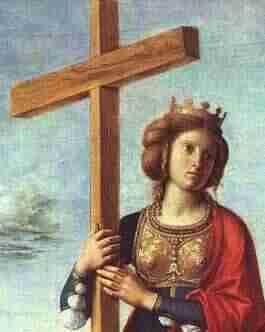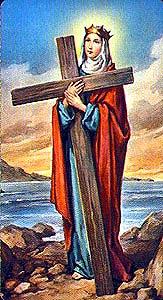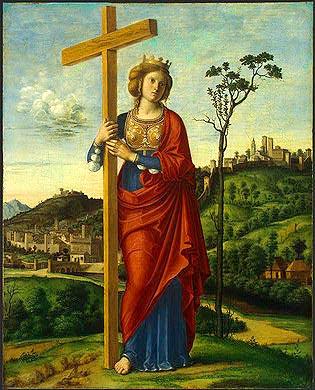My fascination with life and accomplishments of Santa Elena came to me accidentally this year, as I struggled to unravel the traditions and customs of one of Mexico’s most popular Feast Days—May 3rd, the celebration of the Construction workers on the Day of the Holy Cross.
Surprisingly, none of my Mexican friends, not even the Maria Elenas or the construction workers have known that it was Santa Elena, who linked the stone masons and concrete workers with The Cross during the 3rd century. Elena’s story is that of a strong, resilient “today’s woman”, for she was in her 80’s when she made her pilgrimage to Jerusalem to supervise the building of the first temples there.
In the conceit of today’s very enlightened 21st century, few recognize the vision and ability exhibited by Elena, who, as one of the most capable and powerful people in the third century, effected major change in the course of the history of the world and Christianity.
During a remarkable time of intense and rapid change in the Roman Empire, the life of Elena unfolded to reveal her realm of influence as concubine, mother, empress, architect, builder, archaeologist and adventurer. It was, however, her discovery of the True Holy Cross of Jesus, and as a role model to her son, Constantine, Emperor of Rome, that earned her the title in death of Santa Elena.
 Paintings and saints cards from more modern times, show Elena realizing the location of the Holy Cross in a dream or as she organizes and supervises her masons and brick layers in another search for the True Cross. She is usually dressed in clothing fit for royalty and holding a large cross. Frequently, she is shown as a medieval lady with small cross and book, or as Patron Saint of nail smiths, and needle makers, she is shown with a cross and nails, all curious accessories for a simple serving girl, from an innkeeper’s family in the East.
Paintings and saints cards from more modern times, show Elena realizing the location of the Holy Cross in a dream or as she organizes and supervises her masons and brick layers in another search for the True Cross. She is usually dressed in clothing fit for royalty and holding a large cross. Frequently, she is shown as a medieval lady with small cross and book, or as Patron Saint of nail smiths, and needle makers, she is shown with a cross and nails, all curious accessories for a simple serving girl, from an innkeeper’s family in the East.
ELENA-SERVING GIRL AND INNKEEPER
Santa Elena was born Flavia Julia Helena in Drepanum in an Eastern province of the Roman empire (modern Bosnia and Serbia) near the middle of the second century after the death of Jesus Christ. The name Helena is derived from the Greek word Helios meaning sun or light. In other languages, the name becomes Helen, Elena, Elaine, and Eileen.
Elena met Roman General Constantius Chlorus while working as a serving wench in an Asia Minor inn frequented by the officers of the Roman Army. While she and Constantius were a love match, their only choice was to live together in concubinage, an accepted form of cohabitation for people of different social status. At that time, the only appropriate or important reasons to marry were political or financial. Their son, Constantine, was born about 274 in Naissus in Serbia.
Constantius was made a senior officer in the Roman army in Britain, then served as tribune and provincial governor before being elevated by Emperor Maximianus Herculius to be his assistant, the Caesar of the Western Roman Empire, including Britain, Gaul and Spain.
While his new title made him second-in-command, and successor to the emperor of half of the immense Roman empire, the political price was heavy. Maximianus required Elena be put into exile and that Constantius marry Theodora, the emperor’s daughter-in-law. To further secure the relationship between the co-rulers of the empire, Maximianus placed Constantine in the household of Galerius, the Caesar of co-ruler Diocletian, where he was held hostage in the East as a pledge of his father’s good conduct. In 305 Diocletian willingly and Maximianus reluctantly gave over their power and leadership of the empire to their seconds, making Galerius and Constantius the rulers of the empire.
Near this time Constantine was able to slip away in the night, and following a wild ride was joyously reunited with his father in Gaul. Together they set sail for Britain and battle with the Scots.
EMPEROR CONSTANTINE, EMPRESS ELENA
 Constantius died the following year in York, and Constantine was elevated by his troops to the title of Emperor. Constantine made his own political match, putting away his mistress Minervina who was the mother of his oldest son Crispus, and marrying Fausta, the daughter of Maximianus, and the mother of Constantine’s other three sons.
Constantius died the following year in York, and Constantine was elevated by his troops to the title of Emperor. Constantine made his own political match, putting away his mistress Minervina who was the mother of his oldest son Crispus, and marrying Fausta, the daughter of Maximianus, and the mother of Constantine’s other three sons.
As Emperor, Constantine brought Elena to his court, ending their imposed 14-year separation. He immediately elevated her to her rightful position as mother of the emperor, reverently bestowed upon her the title Nobilissima Femina, Most honored and Noble Lady, and changed the name of her birthplace on the Nicomedian Gulf to Helenopolis to honor her.
CONSTANTINE’S VISION, VICTORY AND CONVERSION
By 308, Constantine had defeated Maximianus and had offered his gratitude to the deity Apollo with rich offerings. Soon he was embroiled in a new war against his brother-in-law Caesar Maxentius who was emperor following the death of his father Maximianus.
Just before the decisive battle at the Milvian Bridge on October 12, 312, Constantine experienced a vision of a shining cross in the sky with the inscription “By this sign shall you be victor”. That night, his dreams repeated the vision. The following day Constantine ordered images of the Holy Cross added to all the standards of his army, and the enemy was soundly defeated in one of the most decisive moments of world history.
Upon his triumphant entry into Rome, he first seized the title of Emperor of all Rome, then commanded a statue made of himself holding a cross in his right hand, with the inscription “By this saving sign, I saved the city from the tyrant’s yoke.” Soon Elena joined her son and lived in the south East sector of Rome which included a circus and public baths called Thermae Helena in her honor
It was during these years that Elena started to become known as “the architect” for her work supervising the building of churches for Constantine. For the first time in history, Christians were being allowed to worship openly and to gather without fear of imprisonment. In her convert’s religious zeal, Elena began selecting and procuring sites, funding and supervising churches in Rome. Even the land for the original St. Peter’s Basilica in Rome was purchased by Elena and the first church there built by Constantine.
Elena had been sympathetic to Christianity most of her life, but her conversion came with Constantine’s growing protection and favor for the church. Elena was baptized at the age of 63. Although Constantine also accepted the church, he did not receive the sacrament of baptism until he was quite old and ill as was the current custom.
Although a pagan, Constantine’s father Constantius had not persecuted Christians as was the custom of all his predecessors since the time of Nero, 54-68 A.D. Constantine had witnessed the unusual steadfastness, honesty and duty of the Christians, just as he had seen the horrors of persecution while with Diocletian and Galerius in the East . It is believed that these experiences led to Constantine’s eventual conversion as a Christian, as he said, “I became estranged from those who until then had been rulers, because I saw the savagery of their ways.”
THE END OF PERSECUTION AND THE CATACOMBS
The death of Constantine’s adversary Diocletian marked the end of persecution of Christians, and therefore the need for the secrecy of the Catacombs. Nearly 11 million Christians had already been martyred for their faith by 313 A.D., when Constantine and his brother-in-law and co-ruler of the empire, Licinius signed the Edict of Milan, permitting citizens to accept Christianity without fear of persecution and releasing all religious prisoners.. Their second manifesto ordered the return of all places of assembly and centers of worship seized from Christians, acknowledged the right of Christians to worship and dissolved the law which made being a Christian an offense requiring execution.
Over the next few years, relations between the two Augusti worsened as Licinius returned to a policy of persecution. The battle that brewed came to be a battle involving much of the Roman Empire. The Christian forces were backing Constantine against the pagan supporters of Licinius. While the oracles foretold victory to Licinius, the Christians prayed for Constantine. Christianity triumphed in the battle of Adrianople in 322 A.D. making Constantine sole ruler of the vast Roman Empire and peace briefly rested on both East and West .
The emperor conferred upon Elena the degree of Augusta of Rome, and ordered a series of coins struck in her honor, bearing her image and her title Noblisse Femina.
The triumph of Adrianople was not the end of the conflict between the pagan and Christian forces. In Rome, the pagan forces were powerful enough to make the 20th anniversary of Constantine’s rule so uncomfortable that he left Rome completely to create a new Christian capital on the shores of the Bosphorus, inviting Christian bishops to consecrate it as Constantinople.
Elena continued building in the new city named for her son. According to his decree, in place of pagan temples, Christian churches were to be built during the transformation of the small Greek town of Byzantium into the bustling metropolis Constantinople, the capital of Christianity until 1453.
THE PILGRIMAGES:
 Historians leave little doubt of Elena’s devotion to the Christianity, or of her desire to experience the land where Jesus had lived and prayed. However, her grand pilgrimage to the Holy Lands, Jerusalem, and Palestine was probably also a good will mission. A visit by the mother of the emperor may have been a political conciliation to appease the Eastern parts of the empire, where the people were increasingly dissatisfied with Constantine’s radical religious reforms. Constantine was continuing to replace government officials with Christians. Not only had he ended the persecution of Christians, he also ordered the dramatic suppression of popular pagan cults.
Historians leave little doubt of Elena’s devotion to the Christianity, or of her desire to experience the land where Jesus had lived and prayed. However, her grand pilgrimage to the Holy Lands, Jerusalem, and Palestine was probably also a good will mission. A visit by the mother of the emperor may have been a political conciliation to appease the Eastern parts of the empire, where the people were increasingly dissatisfied with Constantine’s radical religious reforms. Constantine was continuing to replace government officials with Christians. Not only had he ended the persecution of Christians, he also ordered the dramatic suppression of popular pagan cults.
Elena may have been making the trip to restore the faith of the people in her son following a series of unfortunate and undocumented events, which led him in 326 A.D. to order the execution of his wife Fausta and his oldest son Crispus, the son of Minervina. It may have been that the elderly Elena, now nearly her 80th year, was making an act of expiation, either for her own sins or those of her son.
Historian Bishop Eusebius of Caesarea in Palestine, impressed by Elena’s religious enthusiasm, describes her journey, praying where Jesus had prayed, visiting the places Jesus lived and walked, all the while caring for the sick, helping the poor, and building churches, and always searching for a surviving icon, something that she could feel and touch that would be a direct link to Jesus Christ.
FINDING THE CROSS
The story of Elena’s discovery of three crosses on May 3rd is well known in Greek and Latin literature. Some of the most famous of all scholars, Socrates, Sozomen, Theodoretus, Ambrose, Paulinus of Nola reported her search. In the 4th century works by Sulpicius Severus and Rufinus again told her story, and she was the subject of Cynewulf’s most celebrated poem, the 9th century “Elene.”
Elena had been hoping for some time to find the true and Holy Cross. Her son’s visions and dreams of the cross, and his military victory, had linked her mind and soul to the Cross on which Jesus died. In fact, her construction work was often behind schedule, as she took stone masons and construction workers from the churches they were building to dig and search for the cross under her direction.
On the hill called Calvary or Golgotha, the site of Christ’s death, Elena and the Bishop of Jerusalem, St. Macarius, were preparing to build the Basilica of the Holy Sepulcher. A local Jew named Judas (St. Judas Cyriacus) suggested that three centuries of debris that had accumulated over the hill and the caves be removed. Elena ordered the excavation, convinced that the temple to Venus and Jupiter constructed in 135 A.D. by Emperor Hadrian had been built largely to divert Christians from their pilgrimages and from their searches for the tomb of Jesus. Judas believed that they would find the cross near the cave where the body of Jesus had been laid, based on the custom of burying the weapons of execution with the victim.
During the excavation, the remains of three crosses were found in a cave, along with the nails used to crucify Jesus and the placard from the cross of Jesus, declaring him “King of the Jews,”. To determine which was the cross of Jesus, a prominent local woman dying of leprosy was brought, and allowed to touch each of the three crosses on succeeding days. When the woman’s lesions were instantly cleared, they knew which was the True Cross.
When Elena gathered some of the larger pieces of the cross to take to Rome and Constantinople, some of the pieces remained in Jerusalem with Bishop Macarius. On Elena’s triumphant return voyage, her ship encountered extremely rough seas and storms. When the boat was in imminent danger of being destroyed and sunk, she threw one of the nails into the waters, calming the waves instantly
The Basilica of the Holy Sepulcher was consecrated on September 13, 334 A.D. This original building was destroyed by the Persians in 614 A.D., then the second church built in the same location, was destroyed by the Turks in 1009 A.D.. Remains of Elena and Constantine’s foundations support the current Basilica of the Holy Sepulcher begun by the Crusaders in 1048 A.D.
THE EXALTATION OF THE CROSS AND THE DAY OF THE HOLY CROSS
 The Empress Elena’s dying request had been that the faithful to hold a festival annually on May 3rd to remember the day on which the Cross was discovered. The Day of the Holy Cross, was remembered around the world until 1960 when Pope John XXIII removed the celebration from the church calendar, hoping to focus attention on September 14, the Exaltation of the Cross. This fall festival celebrates the return of the major portion of the Jerusalem pieces of the Holy Cross which were recovered by Emperor Heraclius in 629 A.D. after being stolen by the Persians..
The Empress Elena’s dying request had been that the faithful to hold a festival annually on May 3rd to remember the day on which the Cross was discovered. The Day of the Holy Cross, was remembered around the world until 1960 when Pope John XXIII removed the celebration from the church calendar, hoping to focus attention on September 14, the Exaltation of the Cross. This fall festival celebrates the return of the major portion of the Jerusalem pieces of the Holy Cross which were recovered by Emperor Heraclius in 629 A.D. after being stolen by the Persians..
Following her death in Nicomedia around 335 A.D., her remains were returned to Rome where they were venerated in a Mausoleum in the basilica at the Via Labicana in Rome. The sarcophagus, which contained her remains is now in the Vatican museum.
Some of the true Cross preserved by Elena is kept in Rome’s Church of the Santa Croce.
THE RELEVANCE OF ELENA IN THE 21ST CENTURY
Although Elena is usually remembered only for her role in the finding of the Holy Cross, the many other facets of her life, her strength, and the scope of her influence attained global proportions. Although a grand achievement, the discovery of the Cross is considered by most historians as secondary to the effect her example and guidance had on Constantine at a time when other youths of noble birth were being raised in the pagan spirit to despise Christianity.
The advances achieved by Constantine on behalf of Christianity permitted the growth of the Church and stopped the persecution and execution of Christians. The following acts by Constantine are said to be some of the most momentous decisions ever made by a European ruler: he drafted the Edicts of Toleration that made the practice of Christianity legal for the first time in history, and convened the first Ecumenical Council in Nicaea in 325 A.D., resulting in the Nicene Creed.
Constantine also stopped the pagan games, freed the clergy from civic obligations and Church lands from general taxes. He abolished execution by crucifixion, permitted the freeing of slaves without the previously difficult process in the civil courts, forbade sacrifices to idols and protected Christian virgins from sacrifice. In addition, he abolished Roman laws against celibacy, granted the Church the right to receive property by bequest, permitted Christians to occupy the highest state posts, sponsored the building of Christian churches, and abolished the law making it a capital crime to be a Christian. Constantine also restored the name Jerusalem in place of Elia Capitolina, which had been given to the city around 120 by Emperor Hadrian.
In 395 A.D. St. Ambrose of Milan preached on the 65th anniversary of Elena’s death that she had actually found the Holy Cross on which Jesus had hung. She worshipped, said Ambrose, “not the wood, but the King who hung on that wood. She burned with an ardent desire of touching the guarantee of immortality.”
Still these are not the only reasons for which she is remembered. Throughout her long life, she exhibited charity worthy of the mother of the emperor. Among the ordinary people, she represented herself as a humble woman of piety and benevolence, with among her masons and workers she was task master, designer and leader, adventurer.
She represented the best of Christian life, and was an example of that life, long before she openly became a Christian. She humbly provided relief for the poor and was known for her kindness to soldiers, the poor and prisoners. She was zealous for her faith, using her influence and wealth to promote Christianity.
Elena built churches and restored shrines, and according to Eusebius, “continually worshipped in church in the sight of all, humbly dressed among the women praying there. In addition she beautified the churches with ornaments and decorations, not forgetting the chapels of the most insignificant towns and villages.” She devoted much of her life to the exaltation of God, providing temples for his worship. She is credited with building churches in Rome and Britain, as well as temples in Bethlehem, at the site of the Nativity; near Jerusalem, on the Mount of the Ascension; at the Mount of Olives and at Mount Calvary, the site of the crucifixion.
The feast days for Santa Elena are May 21st in the Eastern church and August 18 in the Western church, however, she is also remembered May 3rd in Mexico, the Day of the Holy Cross and on September 14 , the Day of the Exalted Cross commemorating the return of the stolen pieces of the Jerusalem Cross
Elena’s Prayer:
Almighty God, who called your servant Elena to an earthly throne so that she might advance your heavenly kingdom, and filled her with zeal for your Church and love for your people, Grant to us, your people, that we may be fruitful in good works, and steadfast in our faith in you and finally, by your mercy, may attain everlasting life, through Jesus Christ our Lord, who lives and reigns with you and the Holy Sprit, one God, now and ever.




Thanks so much for this article.
I am going through some rough times, and as I was standing by the window, I heard this name, Elena.
I don’t know much about saints, and I wondered what it meant.
A few hours later I fell asleep trying to remember the name, but I couldn’t.
Upon awaking, I heard it again.
It’s not a name of any family or friends.
So, I thought maybe a Saint was trying to tell me something.
Would greatly appreciate if anyone could enlighten me on this.
By the way, lately I have felt that what us going on in my life, is too heavy for me.
Maybe this has to do with it.